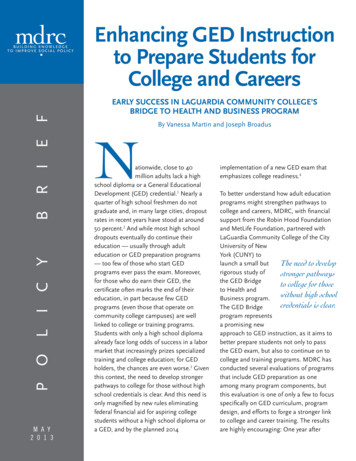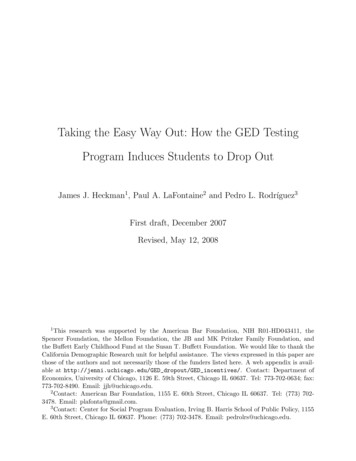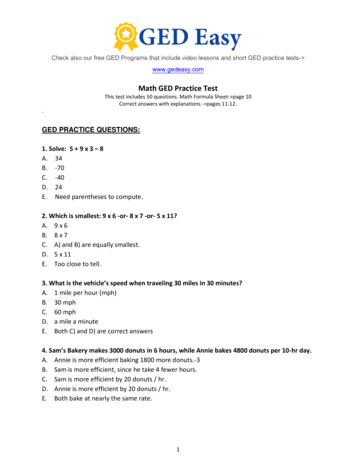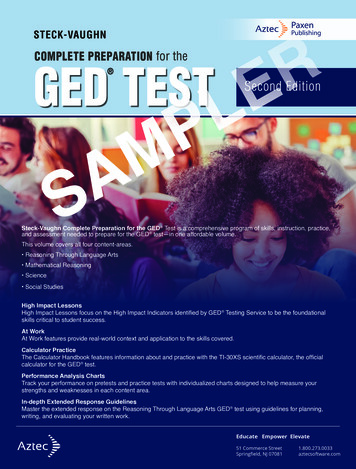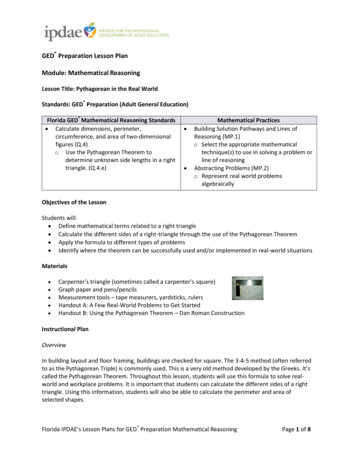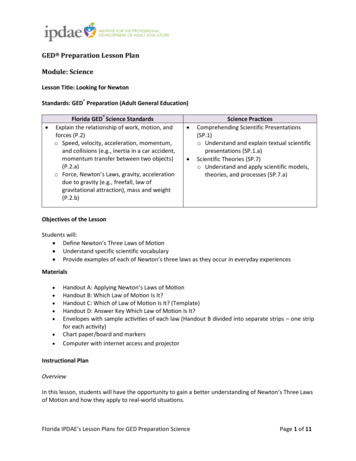
Transcription
GED Preparation Lesson PlanModule: ScienceLesson Title: Looking for NewtonStandards: GED Preparation (Adult General Education)Florida GED Science Standards Explain the relationship of work, motion, andforces (P.2)o Speed, velocity, acceleration, momentum,and collisions (e.g., inertia in a car accident,momentum transfer between two objects)(P.2.a)o Force, Newton’s Laws, gravity, accelerationdue to gravity (e.g., freefall, law ofgravitational attraction), mass and weight(P.2.b) Science PracticesComprehending Scientific Presentations(SP.1)o Understand and explain textual scientificpresentations (SP.1.a)Scientific Theories (SP.7)o Understand and apply scientific models,theories, and processes (SP.7.a)Objectives of the LessonStudents will: Define Newton’s Three Laws of Motion Understand specific scientific vocabulary Provide examples of each of Newton’s three laws as they occur in everyday experiencesMaterials Handout A: Applying Newton’s Laws of MotionHandout B: Which Law of Motion Is It?Handout C: Which of Law of Motion Is It? (Template)Handout D: Answer Key Which Law of Motion Is It?Envelopes with sample activities of each law (Handout B divided into separate strips – one stripfor each activity)Chart paper/board and markersComputer with internet access and projectorInstructional PlanOverviewIn this lesson, students will have the opportunity to gain a better understanding of Newton’s Three Lawsof Motion and how they apply to real-world situations.Florida IPDAE’s Lesson Plans for GED Preparation SciencePage 1 of 11
A scripted PowerPoint presentation accompanies this lesson plan. Each of Newton’s Laws of Motionshould be taught separately using the PowerPoint presentation materials. The presentation provides anintroduction to each of the laws, as well as activities to assist students in synthesizing the informationand applying each of the laws to different real-world experiences. An introductory video by Arpan Jollyand three videos from the Science of NFL, a 10-part video series funded by the National ScienceFoundation, are included within the lesson, as well as selected online instructional and assessmentmaterials from The Physics Classroom. An introduction to each of the three laws is included in thefollowing sections of the lesson plan.ProcessYou may wish to begin this lesson by dropping an apple onto the ground. Share with students the storyabout Sir Isaac Newton and the apple falling from the tree. Although the story is not based in fact, it is awell-known tale about Newton and the “discovery of gravity.” Although the story about the discovery ofgravity is not true, Newton was responsible for identifying numerous scientific laws.Access the PowerPoint and share with students some basic information on Sir Isaac Newton. You maywish to have students research Newton and his life. Show the short video The Best Idea Ever! Discussthat Sir Isaac Newton worked in many areas of mathematics and physics. He developed the theories ofgravitation in 1666 when he was only 23 years old. In 1686, he presented his three laws of motion.These physical principles that were discovered almost 350 years ago, explain how an aircraft flies andmuch, much more. They are a basic part of our physical world.Newton’s First Law of MotionWrite Newton’s First Law of Motion on the board or show the appropriate PowerPoint slide.“An object at rest stays at rest and an object in motion stays in motion with the same speed and in thesame direction unless acted upon by an unbalanced force.”Share with students that this law simply means that objects keep on doing what they’re doing! (Law ofInertia)Demonstrate Newton’s First Law of Motion by using a sheet of printer paper and placing a few heavier(non-breakable) objects on it. Quickly pull the paper out from under the objects.Using the PowerPoint presentation, provide students with the basics of the First Law. The PowerPoint isdesigned to provide the definition of the law, basic definitions and examples, a video applying the law toNFL football, and an additional website to explore. The slides include notes to assist you in presentingthe information.Newton’s Second Law of MotionWrite Newton’s Second Law of Motion on the board or show the appropriate PowerPoint slide.“The relationship between an object’s mass m, its acceleration a, and the applied force F is F ma.”Although the formula can be confusing, this law means that if a force acts on an object, it causes it toaccelerate. The more force applied, the more quickly something accelerations.Florida IPDAE’s Lesson Plans for GED Preparation SciencePage 2 of 11
Demonstrate Newton’s Second Law of Motion by dropping a rock or marble and wadded-up piece ofpaper at the same time. Both items fall at an equal rate—their acceleration is constant due to the forceof gravity acting on them. However, the rock has a much greater force of impact when it hits the ground,because of its greater mass. If you drop the two objects into a dish of sand or flour, you can see howdifferent the force of impact for each object is, based on the crater made.Using the PowerPoint presentation, provide students with the basics of the Second Law. The PowerPointis designed to provide the definition of the law, basic definitions and examples, a video applying the lawto NFL football, and an additional website to explore. The slides include notes to assist you in presentingthe information.Newton’s Third Law of Motion - You Can’t Touch Without Being TouchedWrite Newton’s Third Law of Motion on the board or show the appropriate PowerPoint slide.“For every action, there is an equal and opposite reaction.”Demonstrate Newton’s Third Law of Motion by sitting in a chair with wheels and your feet off theground. With two hands, throw a basketball to someone standing a few feet away. This action shouldcause the chair to move backwards in the opposite direction of the throw. Ask students to describe whatthey saw. Then explain that this was a demonstration of Isaac Newton’s Third Law of Motion – for everyaction there is an equal and opposite reaction.Using the PowerPoint presentation, provide students with the basics of the Third Law. The PowerPoint isdesigned to provide the definition of the law, basic definitions and examples, a video applying the law toNFL football, and an additional website to explore. The slides include notes to assist you in presentingthe information.Sample Debriefing Questions What are Newton’s Laws of Motion?What is inertia?How long will an object remain at rest, according to Newton’s First Law of Motion?What are actions and reactions?What is force?Is speed different than acceleration? Explain.Why are we able to walk on the ground rather than float off into space?Where do Newton’s Laws show up in our daily life?What is one example of each law that you can see in our classroom?Modifications for Different LevelsTo modify instruction, use the videos on Newton’s Three Laws of Motions from StudyJams. Each video isfollowed by a short assessment.Florida IPDAE’s Lesson Plans for GED Preparation SciencePage 3 of 11
Force and Motion - Newton’s First Law: Inertia; Newton’s Second Law: Acceleration; Newton’sThird Law: Action and Reaction. /jams/science/index.htmYou may also wish to modify the readings for students whose reading skills are not at the GED Preparation level. Instead of having them access The Physics Classroom, have them read about Newtonand his Three Laws of Motion from one of the following sites: Newsela (select the appropriate reading level) – Inventors and Scientists: Sir Isaac n/id/15778 Newton’s Laws of Motion by Georgia Louviere, Rice University Teacher Tech louviere/Newton/To modify the assessment tool, have students complete Handout A: Applying Newton’s Laws ofMotion.Assessments/ExtensionsHave students answer questions that you select from the various assessment tools from the The PhysicsClassroom at: s/Newtons-Laws-Packet.This packet is aligned with the online resources that students read as part of the lessons on each of theLaws of Motion.Another assessment tool is to divide the class into small groups. Give each group chart paper that isdivided into three columns or provide each group with a copy of Handout C: Which Law of Motion Is It?Provide each group with an envelope in which you have placed strips with each of the sample activitiesprovided in Handout B: Which Law of Motion Is It?.Have students match each of the activities to the correct law. Have students share their results with theclass and support their reasons for selecting a specific law, especially if there is a disagreement.Florida IPDAE’s Lesson Plans for GED Preparation SciencePage 4 of 11
Handout AApplying Newton’s Laws of MotionNewton’s Lawsof MotionWrite the law here in your own wordsProvide a real-world example of the lawFirst LawSecond LawThird LawFlorida IPDAE’s Lesson Plans for GED Preparation SciencePage 5 of 11
Sample Answer Key - Applying Newton’s Laws of MotionNewton’s Laws ofMotionFirst LawWrite the law here in your own words Provide a real-world example of the lawLaw of inertia, which meanssomething stays the way it is unlessthere is a force that makes it change.When driving to work, a purse is sittingon the passenger seat falls .Second LawF ma, which means that if force isapplied to something it moves. Howquickly it moves, depends on muchforce is applied.It’s easier to push an empty shopping cartthan one which is full of groceries.Third LawFor every action there is an equal andopposite reaction.When you push on a door and it pushesback.Florida IPDAE’s Lesson Plans for GED Preparation SciencePage 6 of 11
Handout BWhich Law of Motion Is It?To dislodge ketchup from the bottom of aketchup bottle, the bottle is often turnedupside down, thrust downward at a highseed and then abruptly halted.F maThe force of gravity on an individual walkingdown a steep hill.Balls of different sizes and weights traveldifferent distances when thrown.Newton’s law that supports the wearing of aseatbelt.Florida IPDAE’s Lesson Plans for GED Preparation SciencePage 7 of 11
A large roller coaster is rapidly acceleratingwhile it is going through curves, turns, andtwists and yet it stays on the track.Bonnie is holding a cup full of coffee as shewalks around the room talking. Not a dropis spilled.A car accelerates faster than a truck.A fish that is swimming in the lake or a birdthat is flying in the air.A rocket accelerates in space.While driving, you notice a bug striking thewindshield of the car.A car comes to a sudden stop, but all ofthe passengers continue to move forward.A magician pulls the tablecloth out fromunder a table full of dishes.Florida IPDAE’s Lesson Plans for GED Preparation SciencePage 8 of 11
Handout CWhich Law of Motion Is It?Newton’s First Lawof MotionFlorida IPDAE’s Lesson Plans for GED Preparation ScienceNewton’s Second Lawof MotionPage 9 of 11Newton’s Third Lawof Motion
Handout DAnswer Key: Which Law of Motion Is It?Newton’s First Lawof MotionNewton’s Second Lawof MotionA car comes to a sudden stop, but all of thepassengers continue to move forward.F maA magician pulls the tablecloth out from undera table full of dishesNewton’s law that supports the wearing of aseatbelt.To dislodge ketchup from the bottom of aketchup bottle, the bottle is often turnedupside down, thrust downward at a high seedand then abruptly halted.Balls of different sizes and weights travel differentdistances when thrown.A large roller coaster is rapidly accelerating whileit is going through curves, turns, and twists andyet it stays on the track.Florida IPDAE’s Lesson Plans for GED Preparation SciencePage 10 of 11Newton’s Third Lawof Motion
Bonnie is holding a cup full of coffee as shewalks around the room talking. Not a drop isspilled.The force of gravity on an individual walkingdown a steep hill.A fish that is swimming in the lake or a birdthat is flying in the air.A car accelerates faster than a truck.While driving, you notice a bug striking thewindshield of the car.A rocket accelerates in space.Florida IPDAE’s Lesson Plans for GED Preparation SciencePage 11 of 11
Florida IPDAE's Lesson Plans for GED Preparation Science Page 1 of 11 GED Preparation Lesson Plan Module: Science Lesson Title: Looking for Newton . Demonstrate Newton's First Law of Motion by using a sheet of printer paper and placing a few heavier (non-breakable) objects on it. Quickly pull the paper out from under the objects.


